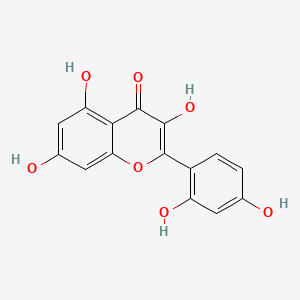D1264 | morin
| Toxicity | Dose | Time | Species | Model | Method | Action | Positive criterion | Reference |
|---|---|---|---|---|---|---|---|---|
| ELECTRON TRANSPORT CHAIN | 60 μM | rat | brain MF0F1-ATPase | decrease | IC50 | 140 | ||
| Target | Dose | Time | Species | Model | Method | Action | Positive criterion | Reference |
|---|---|---|---|---|---|---|---|---|
| ATP synthase | 60 μM | rat | brain MF0F1-ATPase | inhibitor | IC50 | 140 | ||
| Pictogram | Signal | Statements | Precautionary Statement Codes |
|---|---|---|---|
    |
Danger |
Aggregated GHS information provided by 114 companies from 9 notifications to the ECHA C&L Inventory. Each notification may be associated with multiple companies. Reported as not meeting GHS hazard criteria by 2 of 114 companies. For more detailed information, please visit ECHA C&L website Of the 8 notification(s) provided by 112 of 114 companies with hazard statement code(s): H301 (33.93%): Toxic if swallowed [Danger Acute toxicity, oral] H302 (51.79%): Harmful if swallowed [Warning Acute toxicity, oral] H315 (52.68%): Causes skin irritation [Warning Skin corrosion/irritation] H319 (52.68%): Causes serious eye irritation [Warning Serious eye damage/eye irritation] H335 (51.79%): May cause respiratory irritation [Warning Specific target organ toxicity, single exposure Respiratory tract irritation] H341 (49.11%): Suspected of causing genetic defects [Warning Germ cell mutagenicity] H411 (11.61%): Toxic to aquatic life with long lasting effects [Hazardous to the aquatic environment, long-term hazard] Information may vary between notifications depending on impurities, additives, and other factors. The percentage value in parenthesis indicates the notified classification ratio from companies that provide hazard codes. Only hazard codes with percentage values above 10% are shown. |
P201, P202, P261, P264, P270, P271, P273, P280, P281, P301+P310, P301+P312, P302+P352, P304+P340, P305+P351+P338, P308+P313, P312, P321, P330, P332+P313, P337+P313, P362, P391, P403+P233, P405, and P501; (The corresponding statement to each P-code can be found at the GHS Classification page.) |
 |
Warning |
Aggregated GHS information provided by 38 companies from 1 notifications to the ECHA C&L Inventory. Each notification may be associated with multiple companies. H315 (100%): Causes skin irritation [Warning Skin corrosion/irritation] H319 (100%): Causes serious eye irritation [Warning Serious eye damage/eye irritation] H335 (100%): May cause respiratory irritation [Warning Specific target organ toxicity, single exposure Respiratory tract irritation] Information may vary between notifications depending on impurities, additives, and other factors. The percentage value in parenthesis indicates the notified classification ratio from companies that provide hazard codes. Only hazard codes with percentage values above 10% are shown. |
P261, P264, P271, P280, P302+P352, P304+P340, P305+P351+P338, P312, P321, P332+P313, P337+P313, P362, P403+P233, P405, and P501; (The corresponding statement to each P-code can be found at the GHS Classification page.) |
| Organism | Test type | Route | Dose (normalized dose) | Effect | Source |
|---|---|---|---|---|---|
| mouse | LD50 | intraperitoneal | 555mg/kg (555mg/kg) | Archives Internationales de Pharmacodynamie et de Therapie. Vol. 123, Pg. 395, 1960. | |
| 11128-85-1 | 2',3,4',5,7-Pentahydroxy-Flavone | 2',3,4',5,7-Pentahydroxyflavone |
| 2',3,4',5,7-pentahydroxy flavone | 2',3,5,7-Pentahydroxyflavone | 2',4',3,5,7-Pentahydroxyflavone |
| 2',4',5, 7-Tetrahydroxyflavan-3-ol | 2',4',5,7-Pentahydroxyflavone | 2',4',5,7-Tetrahydroxyflavan-3-ol |
| 2',4',5,7-Tetrahydroxyflavonol | 2',5,7-Tetrahydroxyflavan-3-ol | 2'-Hydroxypelargidenolon 1522 |
| 2-(2,4-Dihydroxyphenyl)-3,5,7-trihydroxy-4H-1-benzopyran-4-one, 9CI | 2-(2,4-Dihydroxyphenyl)-3,5,7-trihydroxy-4H-chromen-4-one | 2-(2,4-Dihydroxyphenyl)-3,5,7-trihydroxy-4H-chromen-4-one # |
| 2-(2,4-dihydroxyphenyl)-3,5,7-trihydroxy-1-benzopyran-4-one | 2-(2,4-dihydroxyphenyl)-3,5,7-trihydroxy-4H-1-benzopyran-4-one | 2-(2,4-dihydroxyphenyl)-3,5,7-trihydroxy-chromen-4-one |
| 2-(2,4-dihydroxyphenyl)-3,5,7-trihydroxy-chromone | 2-(2,4-dihydroxyphenyl)-3,5,7-trihydroxychromen-4-one | 2-[2,4-bis(oxidanyl)phenyl]-3,5,7-tris(oxidanyl)chromen-4-one |
| 3,5 7 2 4-Pentahydroxyflavone | 3,5,7,2',4'-Pentahydroxyflavone | 3,5,7,2',4'-Pentahydroxyflavonol |
| 3,7,2',4'-Pentahydroxyflavone | 480-16-0 | 4CH-024478 |
| 4H-1-Benzopyran-4-one, 2-(2,4-dihydroxyphenyl)-3,5,7-trihydroxy- | 4H-1-Benzopyran-4-one, 2-(2,4-dihydroxyphenyl)-3,5,7-trihydroxy-,monohydrate | 4H-1-Benzopyran-4-one, 2-2-(2,4-dihydroxyphenyl)-3,5,7-trihydroxy- |
| 5-18-05-00492 (Beilstein Handbook Reference) | 8NFQ3F76WR | 91A9D69E-FAB0-45CD-90E5-DEEFBADE86C1 |
| A-9317 | ACon1_000260 | AI3-38057 |
| AK111274 | AKOS001582671 | AX8140380 |
| Al-Morin | Aluminum Ionophore I | Aluminum Ionophore I, Selectophore(TM), function tested |
| Aurantica | BBL036670 | BDBM26658 |
| BIDD:ER0115 | BRD-K11590034-001-01-0 | BRN 0327474 |
| BSPBio_003541 | Bois d'arc | Bois d'arc [French] |
| Bois d,Arc | C.I. 75660 | C.I. Natural Yellow 11 |
| C.I. Natural Yellow 11 (VAN) | C.I. Natural Yellow 8 | C.I.Natural Yellow 8 |
| C10105 | CCG-39036 | CCRIS 8680 |
| CHEBI:75092 | CHEMBL28626 | CS-0009616 |
| CTK5B4214 | Calico Yellow | DB-051497 |
| DTXSID1022398 | DivK1c_000958 | EINECS 207-542-9 |
| EU-0100776 | FT-0628989 | Flavone, 2',3,4',5,7-pentahydroxy- |
| Flavone,3,4',5,7-pentahydroxy- | GTPL411 | HMS1921P12 |
| HMS3262K14 | HMS502P20 | HY-N0621 |
| IDI1_000958 | KBio1_000958 | KBio2_001714 |
| KBio2_004282 | KBio2_006850 | KBio3_002824 |
| KBioGR_002268 | KBioSS_001714 | LMPK12112517 |
| LP00776 | LS-69029 | Lopac0_000776 |
| M 4008 | M-8200 | MCULE-2387347344 |
| MEGxp0_001864 | MFCD00006826 | MLS000069618 |
| MLS006012034 | MORIN, REAG | Morin, p.a., 97.0% |
| NCGC00015672-01 | NCGC00015672-02 | NCGC00015672-03 |
| NCGC00015672-04 | NCGC00015672-05 | NCGC00015672-06 |
| NCGC00015672-07 | NCGC00015672-08 | NCGC00015672-09 |
| NCGC00015672-10 | NCGC00015672-11 | NCGC00015672-12 |
| NCGC00015672-13 | NCGC00015672-14 | NCGC00022214-03 |
| NCGC00022214-04 | NCGC00022214-05 | NCGC00022214-06 |
| NCGC00022214-07 | NCGC00178000-01 | NCGC00178000-02 |
| NCGC00261461-01 | NCI60_001647 | NINDS_000958 |
| NSC 19801 | NSC-19801 | NSC19801 |
| Osage Orange | Osage Orange Crystals | Osage Orange Extract |
| P0041 | Q418224 | SBB008853 |
| SC-44859 | SCHEMBL19984 | SDCCGMLS-0003296.P003 |
| SDCCGSBI-0050754.P003 | SMP1_000199 | SMR000058259 |
| SPBio_000929 | SPECTRUM1502259 | SR-01000000157 |
| SR-01000000157-2 | SR-01000000157-6 | SR-01000000157-7 |
| ST24039108 | ST50308676 | STL559049 |
| Spectrum2_000715 | Spectrum3_001941 | Spectrum4_001924 |
| Spectrum5_000737 | Spectrum_001234 | Tox21_500776 |
| Toxylon Pomiferum | UNII-8NFQ3F76WR | X1189 |
| YXOLAZRVSSWPPT-UHFFFAOYSA-N | ZINC3881558 | ZX-AT022489 |
| Zlut prirodni 11 | Zlut prirodni 11 [Czech] | cid_5281670 |
| morin | regid855692 | s9110 |
| CAS Number | 11128-85-1, 480-16-0, 6202-27-3, 654055-01-3 |
| PubChem Compound | 5281670 |
| KEGG Compound ID | C10105 |
| ChEBI | 75092 |
| ChemSpider | 4444989 |
| Wikipedia | Morin (flavonol) |

